Chapter 7. A Neural Circuit That Responds to Motion
7.1 Title slide

A Neural Circuit That Responds to Motion
Explore how motion-selective neurons can represent the speed and direction of moving spots of light.
CLICK ANYWHERE TO BEGIN
Photo: GIPhotoStock / Science Source.
How Do Neural Circuits Detect Motion?
You might think that the neural circuit illustrated in Figure 1 could detect motion. Assume that Neuron M responds strongly only when it receives signals simultaneously from Neurons 1 and 2, which have receptive fields RF1 and RF2 separated by some distance on the retina. Thus, Neuron M monitors the two different retinal locations RF1 and RF2. However, in this circuit Neuron M can't be tuned to represent a particular direction and speed of motion. Let's see why.
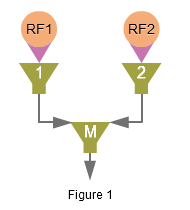
A spot of light moving left to right across the retina strikes RF1, causing Neuron 1 to send a signal to Neuron M. Then the spot of light strikes RF2, causing Neuron 2 to send a signal to Neuron M. Assuming that the signals take the same amount of time to reach Neuron M, the signal from Neuron 1 will arrive at Neuron M before the signal from Neuron 2, and Neuron M won't respond strongly. In this circuit, Neuron M will respond strongly only if RF1 and RF2 are stimulated simultaneously, which clearly isn't what we want from a motion-selective neuron.
However, Neuron M will respond selectively to the direction and speed of motion if the circuit includes a delay in the signals from either Neuron 1 or Neuron 2, as in Figure 2.
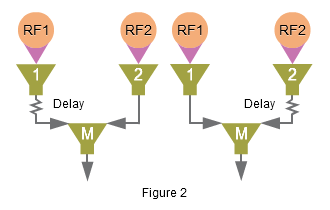
In the circuit on the left, Neuron M is tuned to motion in a left-to-right direction at a specific speed. A spot of light moving in this way stimulates RF1, causing Neuron 1 to send a signal to Neuron M. This signal is delayed by just the right amount to ensure that it arrives at Neuron M simultaneously with the signal from Neuron 2, causing Neuron M to respond strongly. The circuit on the right is tuned in the same way to motion from right to left. This example shows that direction tuning is determined by whether the delay is built into the transmission of signals from Neuron 1 or Neuron 2. (Note that speed tuning is determined by the length of the delay—e.g., a longer delay would tune the circuit to a slower speed of motion.)
7.2 Explain - dnd
Click on a circuit with no delay, a brief delay, or a long delay in the signals from Neuron 1 and Neuron 2 to Neuron M. Then click on a speed and direction arrow to move a spot of light across the receptive fields (RFs) of Neurons 1 and 2. For each circuit, see if you can determine the speed and direction at which the signals from Neurons 1 and 2 arrive simultaneously at Neuron M (or click SHOW ME THE ANSWER). This is the motion that the circuit is tuned to detect.
7.3 Explain
How Do Neural Circuits Detect Motion?
In order to detect and represent the motion of some feature in the retinal image, a neural circuit must monitor at least two different retinal locations and must register the order in which those locations were stimulated and how far apart in time they were stimulated. For a feature moving in a straight line at a constant speed, these pieces of information specify its direction and speed.
You might think that the neural circuit illustrated in Figure 1 could detect motion. Assume that Neuron M responds strongly only when it receives signals simultaneously from Neurons 1 and 2, which have receptive fields RF1 and RF2 separated by some distance on the retina. Thus, Neuron M monitors the two different retinal locations RF1 and RF2. However, in this circuit Neuron M can't be tuned to represent a particular direction and speed of motion. Let's see why.
A spot of light moving left to right across the retina strikes RF1, causing Neuron 1 to send a signal to Neuron M. Then the spot of light strikes RF2, causing Neuron 2 to send a signal to Neuron M. Assuming that the signals take the same amount of time to reach Neuron M, the signal from Neuron 1 will arrive at Neuron M before the signal from Neuron 2, and Neuron M won't respond strongly. In this circuit, Neuron M will respond strongly only if RF1 and RF2 are stimulated simultaneously, which clearly isn't what we want from a motion-selective neuron.
However, Neuron M will respond selectively to the direction and speed of motion if the circuit includes a delay in the signals from either Neuron 1 or Neuron 2, as in Figure 2.
In the circuit on the left, Neuron M is tuned to motion in a left-to-right direction at a specific speed. A spot of light moving in this way stimulates RF1, causing Neuron 1 to send a signal to Neuron M. This signal is delayed by just the right amount to ensure that it arrives at Neuron M simultaneously with the signal from Neuron 2, causing Neuron M to respond strongly. The circuit on the right is tuned in the same way to motion from right to left. This example shows that direction tuning is determined by whether the delay is built into the transmission of signals from Neuron 1 or Neuron 2. (Note that speed tuning is determined by the length of the delay—e.g., a longer delay would tune the circuit to a slower speed of motion.)
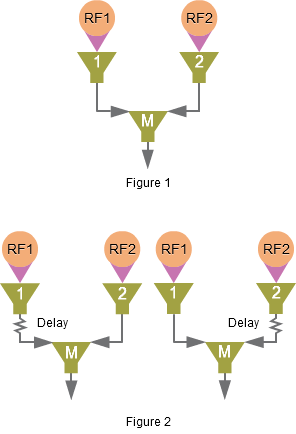
7.4 Test - single choice
Select your answer to the question below. Then click SUBMIT.
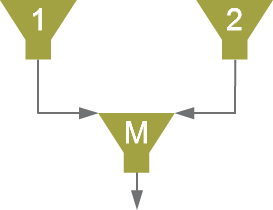
In this demonstration, we concluded that a strong response from Neuron M in a circuit like the one pictured above cannot be the basis for detecting motion. What two assumptions were necessary to reach this conclusion?
7.5 Test - single choice
Select your answer to the question below. Then click SUBMIT.
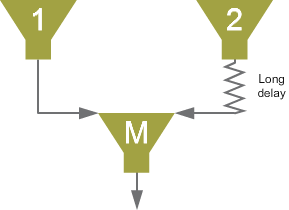
What type of stimulus is most likely to evoke a strong response from Neuron M in the motion-detecting circuit pictured above?
7.6 Test - single choice
Select your answer to the question below. Then click SUBMIT.
Which of the motion-detecting circuits pictured at right is more likely to detect a spot of light moving from left to right at a relatively slow speed?
The correct answer is D.
Click EXPLAIN if you want to review this topic.
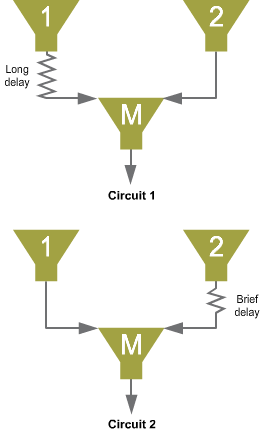
7.7 Activity completed
A Neural Circuit That Responds to Motion.